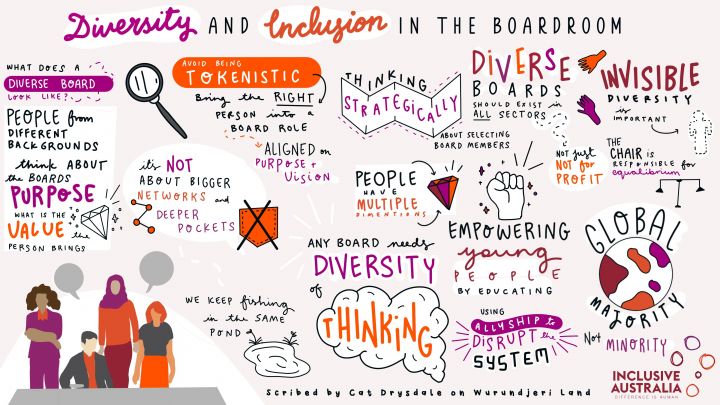Panellists:
In late September 2021, we hosted our latest Emerging Issues Forum. The topic of Diversity and Inclusion in the Boardroom was explored with our three wonderful panellists—Sasha Lawrence, Div Pillay, and Ian Hamm—and we delved into the challenges of creating diverse boards, the areas in which organisations often fall short, and suggestions on improving diversity and inclusion practices in recruitment and board creation.
To view the recorded Forum in full, please click here. Below, find our wrap-up of the Top 8 Takeaways from the Emerging Issues Forum: Diversity and Inclusion in the Boardroom.
Top 8 Takeaways: Diversity and Inclusion in the Boardroom
1. Take a holistic and strategic approach
According to panellist Ian Hamm, a board should ideally comprise no more than nine members. We must therefore be selective, and continually step back to ask, “which mix of people will deliver the best outcome for this organisation?”. This self-assessment is crucial in order to realise specific goals, because achieving outcomes requires the right mix of experts who can most effectively serve the organisation’s audience and stakeholders.
2. “Our problem is that we limit ourselves when it comes to diversity”
Organisations often opt for ‘easy’ recruitment options when attempting to construct diverse boards, but this approach is counterproductive. Rather than a tick-box exercise which seeks out a woman, a person of colour, or a person with a disability, for example, we must not only broaden our mindset, but ensure we’re ensuring each board member can succeed. Panellist Sasha Lawrence notes that in recruitment, “diversity becomes tokenistic when you’re not setting your new members up to actually contribute and succeed on that board”. Especially regarding young people or first-time board members, organisations must lay the foundations for fruitful discussion and proactive decision-making by shifting the focus: diversity is not just a task to be achieved, but an innovative and ever-evolving business decision. It might be difficult to find the right people, with the right skill set and a genuine passion for the organisation, but it’s a worthwhile process to take seriously.
3. Complementary skills and diversity matrices
On a good and functional board, says panellist Div Pillay, the members and their differences will complement each other and enable them to unite for inclusive and innovative decision-making. Often, the art of strategic board design is missing. Organisations should consider the balance of skills, diversity and experience and how these will mix together in practice, by taking an intersectional, multi-layered approach to recruitment rather than the knee-jerk, tokenistic approach we have often seen. This can be achieved beyond recruitment by undertaking an analysis of the board’s composition, creating skill and diversity matrices, and frequently auditing the board. By viewing the board as a mix, we can create a future-ready positioning for the organisation; for example, if we have a 10-year plan, whose voices will be best to bring in to execute and co-design the strategy we require? With this frame of mind—respecting a range of voices, and valuing the role of the Chair—organisations can encourage transformative and long-lasting change.
4. “Diversity of thinking, diversity of skill”
To any role, we bring our backgrounds, our communities, and our previous career experience. This is especially important to remember when curating a board; it’s not an inherent characteristic that you’re hiring, but the entire complex person and their skills surrounding that characteristic. “People are more than one-dimensional,” says Ian Hamm. He flags a hopeful mindset shift which views skills first—for example, a board member might be fantastic at accounting and just happen to be an Aboriginal woman, because her gender and culture are not the sum total of her skill set. The sooner we appreciate that diversity feeds into diverse skills and decision-making that will benefit an organisation, rather than diversity as a tick-box exercise, the better.
5. Diversity of recruitment in the not-for-profit sector
“When we recruit, we have to cast the net wider,” says Sasha Lawrence. In the not-for-profit sector especially, there is a noted tendency to look within our own networks and “fish in the same pond” time and time again. A better approach is to slow the recruitment process down by stepping back and focussing on getting the exact right person into a board role, and looking outside of our own networks to remove any personal bias. Sasha and Ian agree that there is a commonly-held but false idea amongst not-for-profits that board members with “large networks and deep pockets” are the gold standard—an ideal that is a by-product of limited access to adequate funding for NFPs in Australia. In reality, people who have large networks and significant capital access are not always the best fit for fulfilling a vision, and this approach to recruitment can ultimately become unprofitable when it steers the organisation away from its core values.
6. Young people on boards
At the age of 28, Sasha Lawrence was appointed CEO at the Reach Foundation. Until then, he fostered a staunch belief that any boards without someone under the age of 30 were not valuing the voices of young people; but when he began encountering problems he never had before in his new role, he developed a newfound appreciation for more experienced board members. The reason we often see older, more established people on boards, he says, is because their experience and wisdom is incomparable—but often, it is having younger people and a diverse range of ages in leadership which can unlock the value of both younger and more seasoned board members. It can be daunting for first-time board members who can’t help but compare themselves to their tenured colleagues, so it’s important to ask ourselves how we can better empower young people to use their voice once they are on a board. There is a huge—and necessary—opportunity to create pathways for young people to boardrooms in all organisations, not just not-for-profits, to ensure more balanced discussions.
7. Invisible diversities
When strategically recruiting for a ‘diverse’ boardroom, it’s crucial to keep in mind that not all diversities are visible. Diversity exists in disabilities, past struggles, personalities, and lived experiences which lie beneath the surface, and it’s beneficial for both board members and the organisation itself to engage as deeply as possible with these diversities as much as more obvious characteristics like ethnicity, gender, and physical ability. Div Pillay notes that broadening this mindset is necessary to make people feel comfortable in the boardroom; even the language used, such as ‘minority’, can make a huge difference. In Australia, a person who is not white may be seen as belonging to a cultural or ethnic ‘minority’, but this term is entirely reliant on context—“people are only part of a minority within certain groups,” says Div, reminding us that if we shift our focus to a global scale, it is Black, Brown and Asian people who form the “global majority”. Using such language in the boardroom can therefore make members feel small or invisible, as “minority” works to marginalise certain groups from the time they enter a homogenised group, like boardrooms with a majority male or White members.
8. Facilitating deeper discussions
It’s necessary to create a safe and supportive environment in the boardroom to encourage conversations with divergent views. These conversations can “generate ideas and solutions that otherwise might not have been found without conflicting opinions,”, says Sasha Lawrence. Div Pillay adds that the Chair plays a crucial role in facilitating these discussions; the Chair must ensure that all conversations held in the boardroom are deliberate, and that all opinions are considered fairly by other members. Effective chairpersons should encourage the voices of everyone on a board, without offering their own subjective input. Practically, Div suggests that social cohesion on a board is paramount to using allocated meeting time effectively, and encourages individual board members to talk and meet more socially outside of designated times. Ian Hamm adds that the layout of a boardroom aids discussion, and recommends using round rather than rectangular tables to discourage a sense of hierarchy.


Read more stories of organisations improving diversity and inclusion at www.inclusiveaustralia.com.au/news/category/industry
Let us know!

